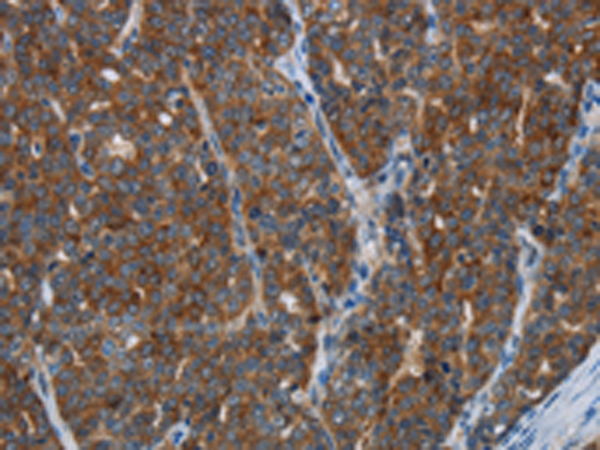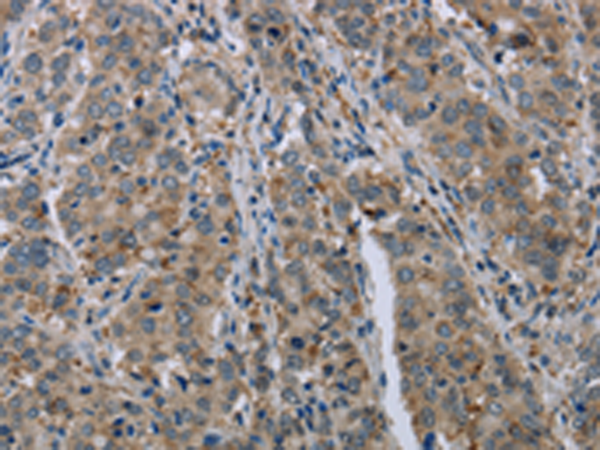

| WB | 咨询技术 | Human,Mouse,Rat |
| IF | 咨询技术 | Human,Mouse,Rat |
| IHC | 1/50-1/200 | Human,Mouse,Rat |
| ICC | 技术咨询 | Human,Mouse,Rat |
| FCM | 咨询技术 | Human,Mouse,Rat |
| Elisa | 1/2000-1/5000 | Human,Mouse,Rat |
| Aliases | HH8; CPPB1; GPR54; AXOR12; KISS-1R; HOT7T175 |
| Host/Isotype | Rabbit IgG |
| Antibody Type | Primary antibody |
| Storage | Store at 4°C short term. Aliquot and store at -20°C long term. Avoid freeze/thaw cycles. |
| Species Reactivity | Human |
| Immunogen | Synthetic peptide of human KISS1R |
| Formulation | Purified antibody in PBS with 0.05% sodium azide and 50% glycerol. |
+ +
以下是关于KISS1R抗体的3篇参考文献的简要列举(基于公开研究整理,非实时数据库查询结果):
1. **文献名称**:*The metastasis suppressor gene KiSS-1 encodes a peptide ligand of a G-protein-coupled receptor*
**作者**:Kotani, M. et al. (2001)
**摘要**:该研究首次鉴定了KISS1R(即GPR54)为KiSS-1基因编码肽(kisspeptin)的受体,揭示了其在抑制肿瘤转移中的作用。文中提到使用KISS1R抗体验证受体在细胞膜上的表达及信号通路激活机制。
2. **文献名称**:*KISS1R/GPR54 in reproductive biology: A key regulator of puberty and fertility*
**作者**:Seminara, S.B. et al. (2003)
**摘要**:探讨KISS1R在生殖调控中的核心作用,发现其突变可导致人类青春期延迟。研究通过KISS1R抗体定位下丘脑神经元中的受体分布,阐明了其在促性腺激素释放激素(GnRH)调控中的功能。
3. **文献名称**:*Expression of Kisspeptin and its receptor GPR54 in the human melanoma microenvironment*
**作者**:Nash, K.T. et al. (2007)
**摘要**:分析KISS1/KISS1R在黑色素瘤中的表达模式,发现其与肿瘤侵袭性负相关。研究利用KISS1R抗体进行免疫组化染色,证实受体低表达与患者预后不良相关,提示其作为潜在治疗靶点。
**备注**:若需具体文献DOI或补充实验细节,建议通过PubMed或SciHub等平台检索最新研究。
KISS1R (Kisspeptin Receptor), also known as GPR54. is a G protein-coupled receptor that binds kisspeptins, neuropeptides encoded by the KISS1 gene. Discovered in 2001. KISS1R gained attention for its critical role in regulating reproductive physiology by activating gonadotropin-releasing hormone (GnRH) neurons, thereby influencing puberty onset and fertility. Dysregulation of the KISS1/KISS1R axis is linked to disorders like hypogonadotropic hypogonadism and precocious puberty. Beyond reproduction, KISS1R is implicated in cancer metastasis suppression, metabolic regulation, and cardiovascular function.
KISS1R antibodies are essential tools for studying receptor localization, expression levels, and signaling mechanisms in tissues. They enable researchers to investigate KISS1R's distribution in the hypothalamus, pituitary, placenta, and peripheral organs using techniques like immunohistochemistry, Western blotting, and flow cytometry. Commercially available antibodies are typically raised against specific epitopes of human or murine KISS1R, with validation in knockout models to ensure specificity. Challenges include cross-reactivity due to structural similarities among GPCRs and variable expression levels in different cell types. Recent studies leverage these antibodies to explore therapeutic potential in infertility treatments and cancer, underscoring their importance in both basic and translational research.
×